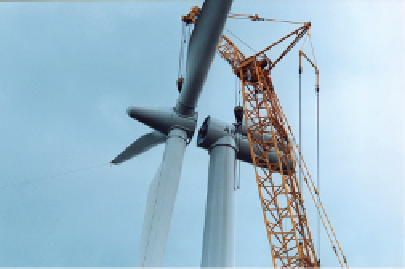Environmental Engineering Reference
In-Depth Information
did the demands placed on crane technology. Today cranes are required to lift many
tons of heavy loads to heights of more than 100 m.
Figure 8.10
Erection of a wind turbine. Top left: Foundation. Right: Tower. Below left: Rotor and
nacelle.
Photos: German WindEnergy Association and ABO Wind AG.
The nacelle (Figure 8.11) forms the heart of modern wind turbines. The nacelle is
mounted to the tower in a rotatable state. The wind measurement device establishes
wind velocity and wind direction. The so-called yaw drive then turns the turbine so
that it faces the wind in an optimal position. The individual rotor blades are attached
to the hub. A shaft starts up the movement of the rotor blades and powers the gears
and the electric generator. The purpose of the gears is to adapt the slower rotation
speed of the rotor to the faster rotation speed of the generator. Although the rotor
of a 5 megawatt turbine 126m in diameter only reaches a rotation speed of a
maximum of 12 revolutions per minutes, the rotor blade tip moves at speeds of over
280 km/h.
Some manufacturers are also promoting wind turbines that do not use gears. Whereas
the electric generator of a wind turbine with gears operates at a rotation speed in
the order of 1000 revolutions per minute, a gearless generator rotates at the rotor
rotation speed. Depending on the size of the wind turbine, this equates to between
6 and 50 revolutions per minute. A generator must be larger in size to use the rela-
tively slower rotor rotation rate. The savings on the gearbox are thus cancelled out



